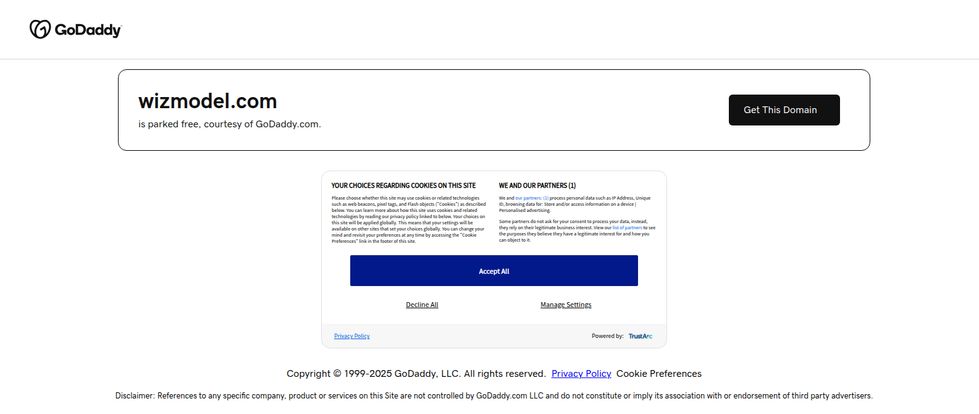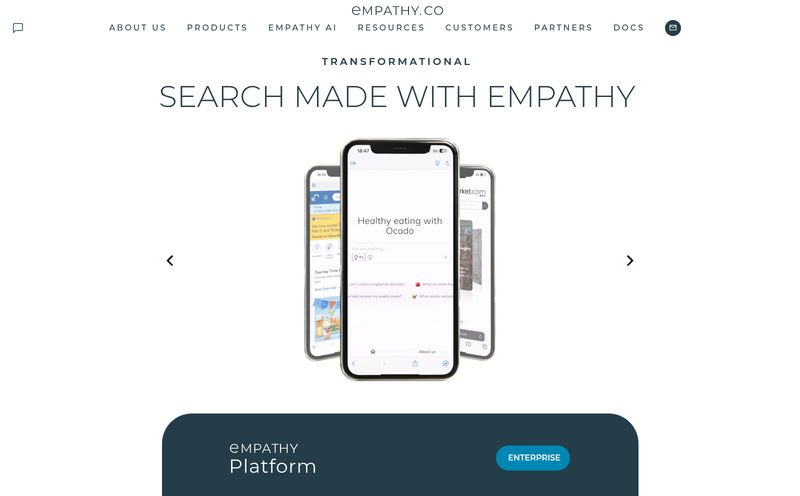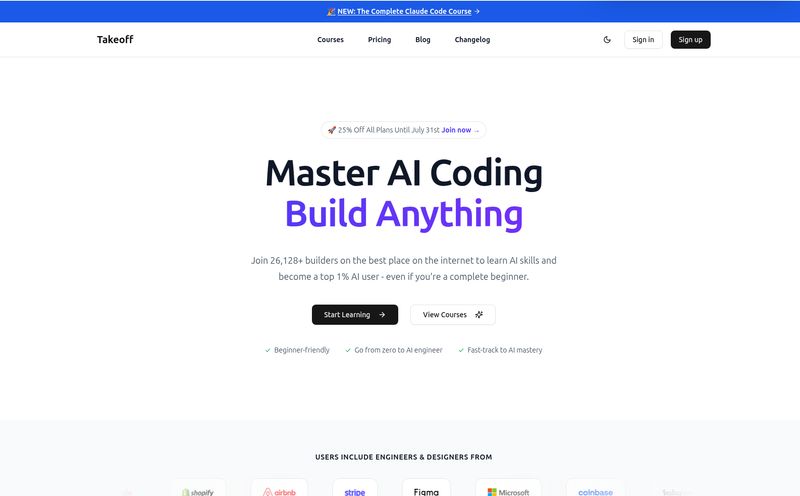You ever get that feeling you’ve stumbled onto a digital ghost town? It happens to me more than I’d like to admit. As someone who’s constantly digging through the web for the next big thing in SEO and traffic generation, I often find myself on the trail of a hot new tool, only to find... well, nothing. A dead end. A 404 page. Or, in this case, a GoDaddy parked domain page.
That's the story of my afternoon with WizModel. I'd heard whispers of a platform that was set to take the headache out of deploying machine learning models. A platform that promised a simple, unified API for a notoriously complex process. My curiosity was piqued, to say the least. But when I went to check it out, I was greeted by the digital equivalent of a tumbleweed rolling past a boarded-up saloon. It seems WizModel, for all its promise, has vanished into the ether.
But that just makes the story more interesting, doesn't it? Let’s put on our detective hats and piece together what WizModel was supposed to be, why it got people like me excited, and what its disappearance teaches us about the wild world of tech startups.

Visit WizModel
What Was the Big Idea Behind WizModel Anyway?
To really get why WizModel even existed, you have to understand the absolute nightmare that deploying machine learning models can be. I've worked with dev teams on this stuff, and it's not pretty. You've got your data scientists, brilliant people who can build a model that can predict customer churn with spooky accuracy. But then they hand it over to the engineers and say, "Make this work on our servers." And that's when the fun begins.
The Deployment Headache We All Know and Hate
Suddenly, you're in a world of pain. You’re wrestling with Python dependencies that conflict with each other, trying to figure out the right GPU drivers, and setting up Docker containers that just refuse to build. It's a mess. And even if you get it running, what happens when your traffic spikes? You have to manually scale up your servers, and then scale them back down to avoid a terrifying cloud bill. It’s a full-time job in itself, and it’s a massive bottleneck to getting cool AI features out the door.
WizModel's Promise: One API to Rule Them All
This is the problem WizModel aimed to solve. The core concept was beautifully simple: a unified API for ML inference. Instead of building all that complex infrastructure yourself, you could just package your model, hand it to WizModel, and they’d give you a simple API endpoint. You send your data to the API, and you get your prediction back. That's it.
They handled all the ugly stuff in the background – the scaling, the server configuration, the GPU management. It was meant to be true serverless machine learning. You, the developer, could focus on building your app, not on becoming a part-time DevOps engineer. A truly seductive idea, right?
Popping the Hood on WizModel's Tech
So how was this magic supposed to work? From the breadcrumbs left behind, it seems to have been built on a couple of clever ideas.
The Role of Cog2
The key piece of the puzzle appears to be a tool called Cog2. Now, my research shows that Cog is an open-source tool from the folks over at Replicate, another big player in this space. Cog is designed to package machine learning models into standard, production-ready containers. It takes your model code, its Python dependencies, and system libraries and wraps them all up in a neat little bow.
By leveraging something like Cog2, WizModel could standardize the way it accepted models. This meant they could build a single, robust system to run thousands of different models without custom-tweaking things for every single user. It's a smart way to build a scalable platform, but it also meant users would have to learn how to use Cog2. A bit of a learning curve, but probably a worthwhile one.
Pay-By-The-Second: A Breath of Fresh Air for Budgets
Another major selling point was the billing model: pay-by-the-second. This is huge. Most cloud providers bill you for GPU instances by the hour. So, if your model only runs for 10 seconds to process a request, you still often pay for the full hour that the server was on standby. It's incredibly inefficient.
WizModel's model meant you only paid for the exact compute time you used, right down to the second. For applications with inconsistent or spiky traffic, this could mean massive cost savings. It turns a hefty fixed cost into a much more manageable variable cost. It’s the kind of feature that makes CFOs and budget-conscious founders breathe a huge sigh of relief.
The Good, The Bad, and The Missing
Looking at the specs, it’s easy to see the appeal. It had all the makings of a really useful service. The pros were obvious: simplified deployment, the power of a unified API, automatic scaling to handle anything from a trickle to a flood of traffic, and that fantastic pay-by-the-second billing. Plus, the promise of a community where you could use thousands of pre-existing models was a huge draw for teams that didn’t have their own data scientists.
But there were potential downsides, too. The reliance on Cog2 meant another tool to learn. And there was always the risk of platform lock-in—what happens if you build your entire workflow around WizModel and then… well, and then they disappear? It's a bit ironic, looking back.
"The promise of a simplified, scalable MLOps platform is the holy grail for many developers. Tools like WizModel, even in concept, show us where the industry is heading—even if some don't make it to the finish line."
So, What Happened to WizModel?
This is the million-dollar question, isn't it? A promising platform with a clear value proposition, and now its domain is just… parked. I've seen this play out a few times in the industry, and it usually comes down to one of a few scenarios:
- Acquisition: A larger company might have bought them for their tech or their team (an "acqui-hire") and then shut down the public-facing product to integrate it into their own systems.
- Funding Dried Up: The startup world is brutal. They might have had a great product but failed to secure their next round of funding to keep the lights on.
- A Pivot: Maybe they realized their initial approach wasn't working and have gone back to the drawing board, planning to relaunch as something else entirely.
- Project That Never Launched: It could have been a promising side-project that just never got the traction or resources to become a full-fledged company.
My gut tells me it’s likely a mix of funding issues or a quiet acquisition. The AI space is white-hot right now, and good ideas get snapped up fast. Either way, it’s a shame to see a potentially great tool vanish without a trace.
Lessons from a Digital Ghost
The story of WizModel, though short and mysterious, is a great lesson. It highlights the incredible demand for tools that simplify the machine learning lifecycle. The idea is rock-solid. Developers are desperate for solutions that let them use AI without needing a Ph.D. in distributed systems.
It also serves as a reminder of the volatility of relying on new, unproven platforms. When choosing a tool to build your business on, stability and a clear roadmap are just as important as cool features. For those looking for similar solutions that are still around, you might check out platforms like Replicate, Banana.dev, or the inference endpoints offered by Hugging Face. They all tackle the same problem with slightly different approaches.
Frequently Asked Questions about WizModel
- What was WizModel?
- WizModel was a platform designed to simplify the deployment and scaling of machine learning models. It offered a unified API, automatic scaling, and a pay-by-the-second billing model to make it easier and more cost-effective for developers to use AI in their applications.
- Is WizModel still active?
- As of late 2024, it appears WizModel is no longer active. Its official domain, wizmodel.com, is currently a parked page, suggesting the service has been discontinued.
- How did WizModel's pricing work?
- WizModel was marketed with a pay-by-the-second pricing model. This meant users were only charged for the exact amount of computation time their models used, which is a highly cost-effective method for applications with variable traffic.
- What is Cog2?
- Cog (and presumably its successor, Cog2) is an open-source tool that packages machine learning models into standard, portable containers. This allows platforms like WizModel to run a wide variety of models in a standardized environment. It was a core part of their infrastructure.
- What are some good alternatives to WizModel?
- If you're looking for ML model deployment platforms, there are several strong alternatives available. Some popular choices include Replicate, Banana.dev, and the inference solutions provided by major players like Hugging Face, AWS SageMaker, and Google's Vertex AI.
A Final Thought
While WizModel might be a ghost in the machine for now, its spirit lives on. The problems it tried to solve are real, and the solutions it proposed are the future of MLOps. It’s a reminder that in the fast-paced world of tech, even the best ideas can flicker out. But they always light the way for the next innovation. So here’s to the ghosts, the what-ifs, and the tools that dared to make our lives just a little bit easier.
Reference and Sources
- Cog Open-Source Tool: https://replicate.com/blog/cog-dev
- Replicate Platform: https://replicate.com/
- Hugging Face Inference Endpoints: https://huggingface.co/inference-endpoints



